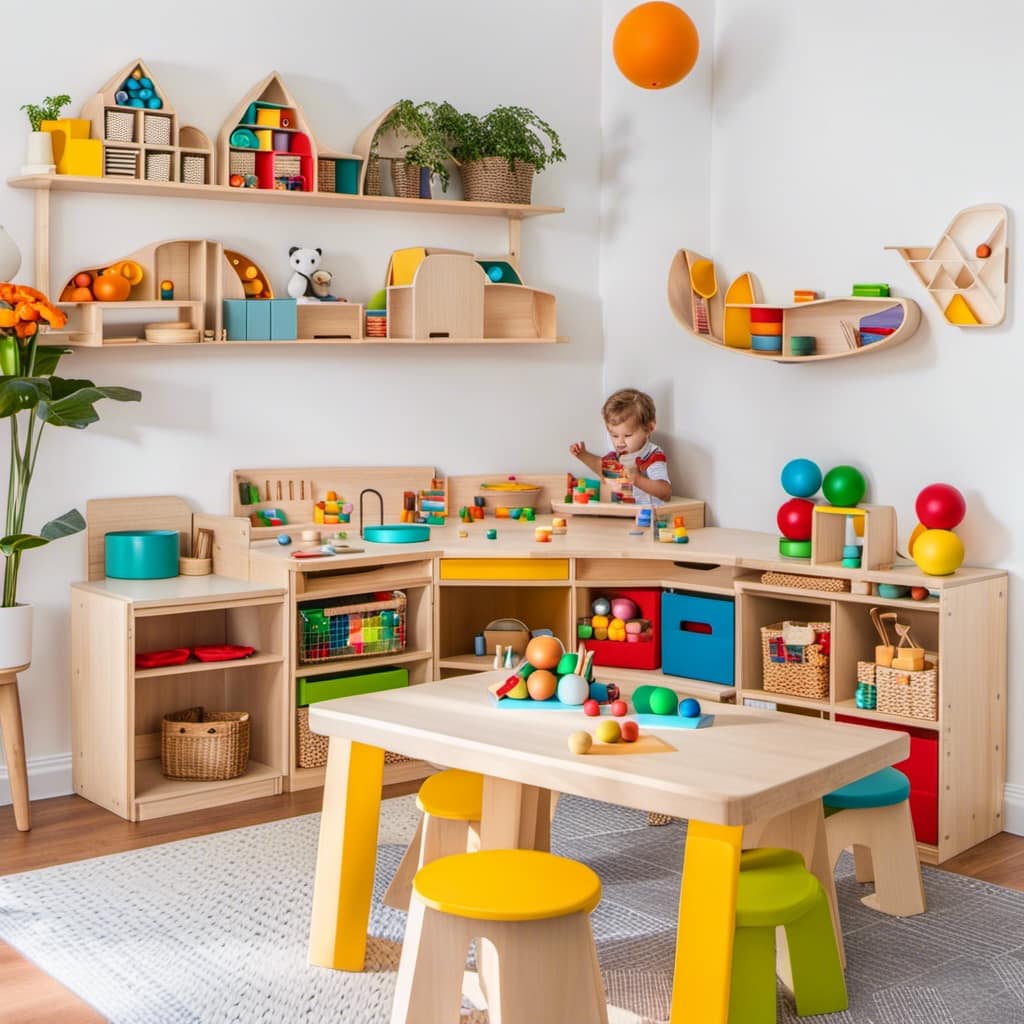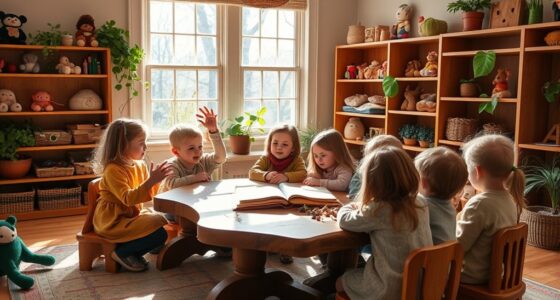Making DIY Waldorf toys is a wonderful way to craft simple, natural playthings that nurture imagination and sustainability. Using materials like wool, cotton, and wood, you can create charming woodland animals, soft dolls, and more. These toys are durable, safe, and sensory-friendly, promoting emotional growth and exploration. Enjoying this process also encourages mindfulness and craftsmanship. If you’re interested in creating textured, timeless toys that your children will cherish, you’ll find plenty of inspiration ahead.
Key Takeaways
- Use natural materials like wool, cotton, and wood to create safe, eco-friendly Waldorf toys.
- Craft simple figures such as woodland animals or dolls with minimal, soft features to inspire imagination.
- Sew, stuff, and assemble using gentle techniques that promote mindfulness and attention to detail.
- Personalize toys with embroidered faces or yarn hair to make unique, comforting companions.
- Focus on quality craftsmanship to produce durable, heirloom-quality toys that encourage creative play.

Creating your own Waldorf toys allows you to craft beautiful, natural playthings that nurture a child’s imagination and development. When you make woodland animals or handmade dolls, you’re not just creating toys—you’re fostering a sense of wonder and connection to nature. These simple, thoughtfully crafted items serve as timeless companions that inspire storytelling, role-playing, and emotional growth. By choosing natural materials like wool, wood, and cotton, you guarantee that these toys are safe, eco-friendly, and tactilely appealing.
Woodland animals are a perfect example of how you can bring nature into play. Using soft wool for the animals’ bodies and wooden buttons for eyes, you can create charming foxes, rabbits, owls, and deer that feel real and inviting. These toys encourage children to explore their surroundings, develop fine motor skills, and engage in imaginative scenarios. Because woodland animals are versatile, they can be used in forest-themed stories, classroom activities, or simply as decorative objects that add warmth to a child’s play space. Making these creatures is straightforward—cutting, sewing, and stuffing natural fibers—yet the end result is a durable, enchanting toy that can be treasured for years.
Handmade dolls are another cornerstone of Waldorf-inspired play. These dolls are often minimalist, with soft, simple features that allow children to project their own stories and emotions onto them. You can craft dolls with cloth bodies, yarn hair, and embroidered faces, making sure they are gentle to touch and safe for little hands. The process of making dolls encourages patience and attention to detail, and the resulting toy becomes a cherished keepsake. These dolls can serve as comforting companions during playtime or bedtime, helping children process feelings and develop empathy. Plus, creating your own dolls allows you to customize their appearance and accessories, assuring each one is uniquely suited to your child’s personality and interests.
When you craft woodland animals and handmade dolls, you’re engaging in a meaningful, mindful activity that yields more than just toys. These natural playthings promote creativity and connection, emphasizing the importance of quality over quantity. Your efforts result in beautiful, durable items that can be handed down through generations. Overall, making Waldorf toys yourself is a rewarding way to foster a nurturing environment, where imagination and nature intertwine seamlessly.
Frequently Asked Questions
What Safety Precautions Should I Take When Making Waldorf Toys?
When making Waldorf toys, you should prioritize safety by using non-toxic finishes and child-safe adhesives. Always guarantee your workspace is clean and well-ventilated to avoid inhaling fumes. Check that all materials are free of small parts that could be choking hazards, and thoroughly inspect your finished toys for sharp edges or loose parts. By taking these precautions, you create safe, beautiful toys that children can enjoy confidently.
How Can I Personalize DIY Waldorf Toys for My Child’s Interests?
Ever imagined your child’s face lighting up with a toy they truly love? You can personalize DIY Waldorf toys by incorporating their interests with unique personalization ideas. Think about using their favorite colors, characters, or themes. Consider adding hand-painted details or customizable features that reflect their preferences. By tailoring each detail, you create a meaningful toy that sparks imagination and shows how much you care about their individual preferences.
What Are Eco-Friendly Alternatives for Traditional Craft Materials?
You can choose eco-friendly alternatives by prioritizing sustainable sourcing for your craft materials, ensuring they’re ethically harvested or made from renewable resources. Opt for natural dyes derived from plants, fruits, or vegetables to add vibrant, non-toxic colors to your toys. Avoid synthetic paints and plastics, and instead, use organic cotton, wool, or wood from local, responsible sources. This way, your handmade toys stay safe for your child and gentle on the environment.
How Long Do Homemade Waldorf Toys Typically Last?
Think of your homemade Waldorf toys as a fine wine—they improve with care and last for years. Typically, with proper toy durability and maintenance tips, these natural playthings can last from several years to decades. You might notice a wooden rattle that’s been handed down through generations. Regularly check for splinters, clean with a damp cloth, and store in a dry place to keep them in top shape.
Are There Age-Specific Guidelines for Crafting Waldorf Toys?
You should consider age-specific guidelines when crafting Waldorf toys to guarantee safety and developmental appropriateness. Focus on age-appropriate designs that match a child’s developmental considerations, like simple, natural materials for infants and more complex, textured toys for older kids. Always prioritize non-toxic finishes and avoid small parts for young children, creating toys that support their growth and curiosity while adhering to safety standards for each age group.
Conclusion
Creating your own Waldorf toys not only nurtures your child’s imagination but also connects them with nature’s simplicity. Did you know that children who play with natural materials show improved sensory development and emotional regulation? By crafting these toys yourself, you foster a mindful, eco-friendly environment that encourages creative play. So grab some natural materials and start making these delightful, timeless treasures—your child will thank you with endless curiosity and joy.











